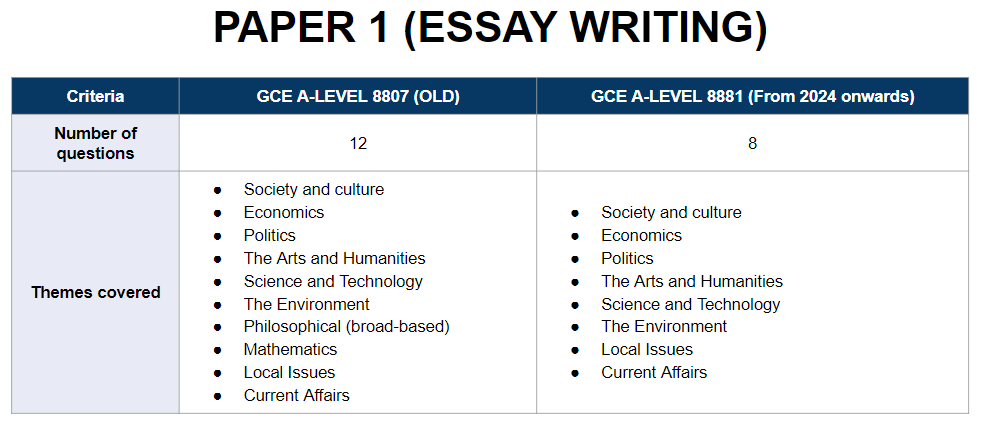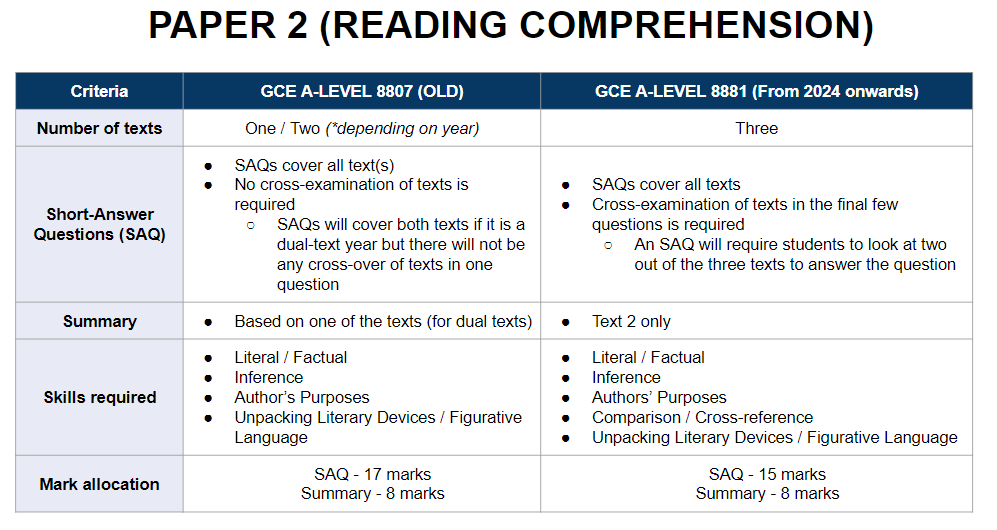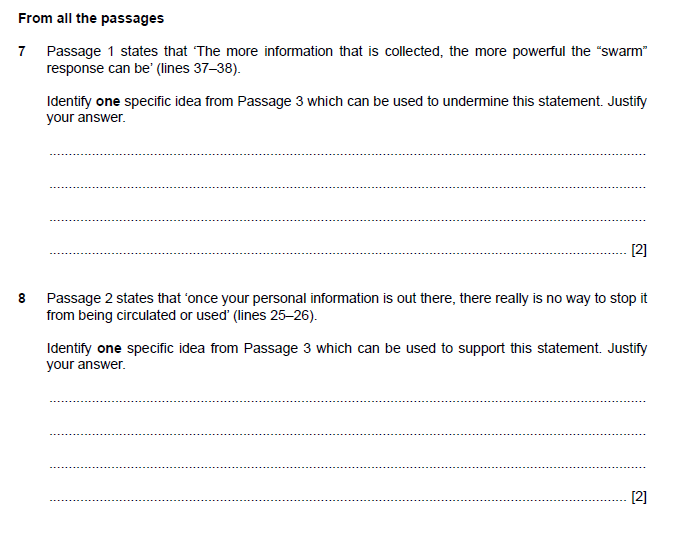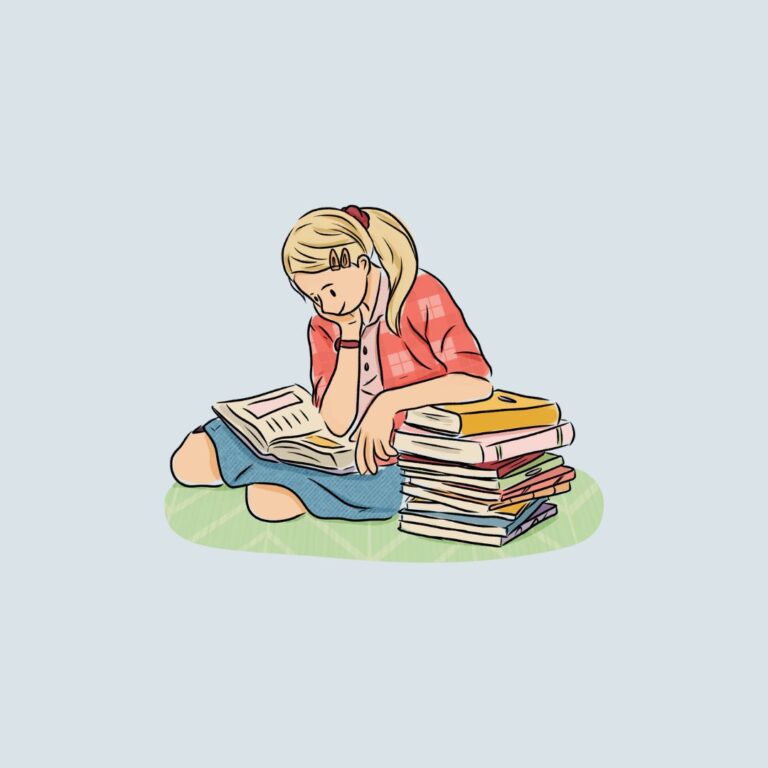Starting from the new Academic Year 2024 onwards, the GCE A-Level Syllabus will be updated from 8807 to 8881. With the exception of Private Candidate students repeating the A-Levels in 2024, students who are in Junior College 2, Integrated Programme Year 6 and Pre-University Year 3 will have to undergo the new examination syllabus in 2024.
Below are the differences observed:
For Paper 1

1. Number of questions has been reduced
While General Paper is known for covering a wide range of topics, the new exam syllabus will see a reduction in the number of themes covered. However, many of the themes that remain are still relatively broad.
- Topics that are philosophical in nature or related to Mathematics will be subsequently removed. Examples of questions that will no longer be applicable include:
- Consider the view that mathematics is of little interest to most people as it is too complex. (GCE 2022)
- ‘Everyone has an opinion, but not everyone’s opinion is of equal value.’ What is your view? (GCE 2016)
What Blue Herring Academy has to offer
- As the essay questions that will be removed are mostly unpopular question choices in the first place, there would not be much changes made to the way question selection and writing skills are being taught.
- Most of the resource materials will still primarily focus on the popular topics such as Science & Technology and Environment, but with greater emphasis on skills and techniques to write fluently and coherently.
For Paper 2 (Reading Comprehension – SAQ & Summary)

2. Number of texts has increased
- Instead of having one or two texts (alternating every year), the new exam syllabus will include three texts regardless of the year.
- SAQs will test questions based on all three texts.
- Text 2 for the new exam syllabus will be exclusively testing on Summary.
3. New question types for Short-Answer Questions (SAQs)

(*screenshot obtained
from GCE A-level 8881 General Paper Specimen Paper 2 Question Paper)
- Unlike questions in the previous exam syllabus where they focus on specific paragraphs within a text, the new syllabus will have a few questions (4 to 6 marks in total) that require students to cross-reference two texts.
- In a bid to ensure that students hone their cross-referencing skills, such questions are introduced towards the end of the SAQ section.
4. Summary now has wider search parameters / boundaries
- In the previous exam syllabus, Summary search boundary is only based on selected paragraphs of one of the passages (for dual-text years) or the passage (single-text years). The Summary component for the new exam syllabus will cover one out of the three entire text passages.
- An opening phrase will also no longer be given to help students start their paragraph (e.g. One of the benefits of tourism is…)
5. Mark allocation has changed
- Mark allocation for SAQ has been reduced from 17 marks to 15 marks for the new exam syllabus. This means that time will need to be reallocated elsewhere.
What Blue Herring Academy has to offer
- As there are now three texts to consider, students will have to be much more savvy with time management. Paper 2 is already a struggle for many students to complete and the introduction of an additional text and cross-referencing questions would mean that students need to really grasp Paper 2 skills and techniques well within time constraints. Thus, there will be more timed practices to ensure students master the specific Paper 2 components within time constraints.
- Summary strategies will be taught to students to select Content Points (CPs) more effectively.
- Recommendations to start the Summary paragraph concisely will also be given to help students.
- Exam time management tips would also be imparted to help students manage their time effectively.
For Paper 2 (Reading Comprehension – Application Question)

(*screenshot obtained from GCE A-Level 8881 General Paper Specimen Paper 2 Question Paper)

6. Though not major, the question structure of AQ has changed
- There are minor changes to the AQ but the core requirements stay relatively the same for this new exam syllabus.
- Instead of having to reference both texts in dual-text years, the new exam syllabus requires students to reference at least one. However, it is still encouraged to reference two texts to ensure a wider scope and depth of discussion.
- Mark allocation has increased from 10 marks to 12 marks, thereby indicating a greater emphasis on students evaluating text passages and their application to local context.
- Just like the previous exam syllabus, students would need to bring in examples from Singapore society and their personal experiences.
What Blue Herring Academy has to offer
- The usual AQ skills and techniques will still apply in this new exam syllabus but greater emphasis will be given since the mark allocation has increased from previous exam syllabus.
Overall, these are the changes made to the General Paper syllabus and our observations. It is important to be mindful of these changes and how that affects the approaches to the different paper components.




